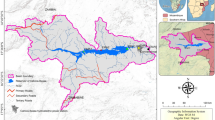Abstract
Differential evolution (DE) is a population-based evolutionary algorithm widely used for solving multidimensional global optimization problems over continuous spaces, and has been successfully used to solve several kinds of problems. In this paper, a novel expression for the prediction of longitudinal dispersion coefficient in natural streams is proposed to minimize the sum-square error using differential evolution algorithm. The new expression considers the hydraulic and geometric characteristics of rivers. Datasets consisting 65 sets of observations from 29 rivers in the unite states are used to test the proposed algorithm, and results demonstrate the performance and applicability of the proposed differential evolution. Compared with the previous methods, the new expression using differential evolution is superior to other expressions. Moreover, 56.92 % of the prediction using the new expression lie with the 0.5 < K pre /K meas < 1.5 that is better than other expressions.






Similar content being viewed by others
References
Brest J, Greiner S, Boskovic B, Mernik M, Zumer V (2006) Self adapting control parameters in differential evolution: a comparative study on numerical benchmark problems. IEEE Trans Evol Comput 10(6):647–657
Deng ZQ, Singh VP, Bengtsson L (2001) Longitudinal dispersion coefficient in straight rivers. J Hydraulic Eng 127(11):919–927
Elder JW (1959) The dispersion of a marked fluid in turbulent shear flow. J Fluid Mech 5(4):544–560
Fischer BH (1967) The mechanics of dispersion in natural streams. J Hydr Div ASCE 93(6):187–216
Fischer BH, List EJ, Koh RCY, Imberger J, Brooks NH (1979) Mixing in inland and coastal waters. Academic, New York, pp 104–138
Kashefipour SM, Falconer RA (2002) Longitudinal dispersion coefficients in natural channels. Water Res 36(6):1596–1608
Li X, Yin M (2012a) Hybrid differential evolution with artificial bee colony and its application for design of a reconfigurable antenna array with discrete phase shifters. IET Microw, Antennas Propag 6(14):1573–1582
Li X, Yin M (2012b) Application of differential evolution algorithm on self-potential data. PLoS One 7(12):e51199
Li X, Yin M (2013) An opposition-based differential evolution algorithm for permutation flow shop scheduling based on diversity measure. Adv Eng Softw 55:10–31
Li X, Wang J, Zhou J, Yin M (2011) A perturb biogeography based optimization with mutation for global numerical optimization. Appl Math Comput 218(2):598–609
Liu H (1977) Predicting dispersion coefficient of streams. J Environ Eng Div 103(1):59–69
Neri F, Tirronen V (2009) Scale factor local search in differential evolution. Memet Comput J 1(2):153–171
Qin AK, Huang VL, Suganthan PN (2009) Differential evolution algorithm with strategy adaptation for global numerical optimization. IEEE Trans Evol Comput 13(2):398–417
Qin H, Zhou JZ, Lu YL, Li YH, Zhang YC (2010) Multi-objective cultured differential evolution for generating optimal trade-offs in reservoir flood control operation. Water Resour Manag 24(11):2611–2632
Rahnamayan S, Tizhoosh HR, Salama MMA (2008) Opposition-based differential evolution. IEEE Trans Evol Comput 12(1):64–79
Sahay RR, Dutta S (2009) Prediction of longitudinal dispersion coefficients in natural rivers using genetic algorithm. Hydrol Res 40(6):544–552
Seo IW, Cheong TS (1998) Predicting longitudinal dispersion coefficient in natural streams. J Hydraulic Eng 124(1):25–32
Storn R, Price K (1997) Differential evolution-a simple and efficient heuristic for global optimization over continuous space. J Glob Optim 11(1):341–359
Taylor GI (1953) Dispersion of soluble matter in solvent flowing slowly through a tube. Proc R Soc Lond Ser A 219:186–203
Taylor GI (1954) The dispersion of matter in turbulent flow through a pipe. Proc R Soc Lond Ser A 223:446–468
Vasan A, Raju KS (2007) Application of differential evolution for irrigation planning: an Indian case study. Water Resour Manag 21(8):1393–1407
Zhang JQ, Sanderson AC (2009) JADE: adaptive differential evolution with optional external archive. IEEE Trans Evol Comput 13(5):945–958
Acknowledgments
This research is fully supported by Opening Fund of Top Key Discipline of Computer Software and Theory in Zhejiang Provincial Colleges at Zhejiang Normal University under Grant No. ZSDZZZZXK37 and the Fundamental Research Funds for the Central Universities Nos. 11CXPY010. Guangxi Natural Science Foundation (No. 2013GXNSFBA019263), Science and Technology Research Projects of Guangxi Higher Education (No.2013YB029), Scientific Research Foundation of Guangxi Normal University for Doctors.
Author information
Authors and Affiliations
Corresponding author
Rights and permissions
About this article
Cite this article
Li, X., Liu, H. & Yin, M. Differential Evolution for Prediction of Longitudinal Dispersion Coefficients in Natural Streams. Water Resour Manage 27, 5245–5260 (2013). https://doi.org/10.1007/s11269-013-0465-2
Received:
Accepted:
Published:
Issue Date:
DOI: https://doi.org/10.1007/s11269-013-0465-2




